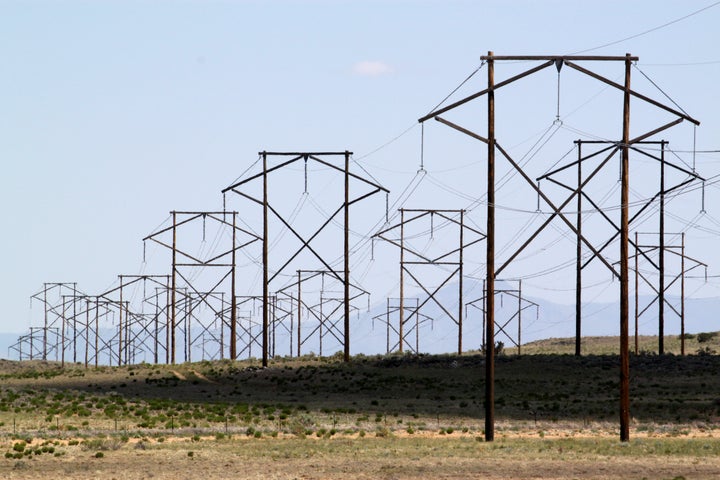The Biden administration rolled out its plan Thursday to overhaul the United States’ aging patchwork of fossil-fueled electrical grids, finishing work on a suite of regulations designed to rein in rising utility bills and stem worsening blackouts while cutting planet-heating pollution from power plants.
The regulatory package includes the nation’s first-ever limits on greenhouse gas emissions from power plants, tighter restrictions on mercury gas and coal ash, and a new way to speed up construction of badly needed transmission lines.
Paired with the billions of dollars in carrots for manufacturing, building and buying modern energy equipment that came with President Joe Biden’s landmark climate-spending laws, the rules chart a path for the U.S. to avoid nearly 1.4 billion metric tons of carbon pollution through 2047. That’s equal to taking 328 million gasoline-fueled cars off the road or a full year of emissions from the U.S. electric power sector today.
The most hotly anticipated part of the package is the Environmental Protection Agency’s power plant rule requiring most existing coal-fired and new natural-gas-burning power plants to capture 90% of carbon from smokestacks before it enters the atmosphere or to shut down as early as 2039.
The existing natural gas plants that today provide more than 43% of the country’s electricity are exempt from the regulation, as are new natural gas stations that primarily switch on to shore up supply on the grid when demand is especially high or output from weather-dependent sources, such as solar panels and wind turbines, is shaky. Faced with industry blowback to its initial plan to regulate existing gas plants, the EPA opened a formal question-asking session last month to gather information on ways to approach cutting emissions from today’s fleet.
“What we’re doing with the status of existing natural gas plants is directly in response to our stakeholders, both our industry stakeholders and our environmental stakeholders, who said, ‘You can do better,’” EPA Administrator Michael Regan said on a call with reporters Wednesday afternoon. “We decided to take that challenge.”
The rule also defines criteria for “systems emergencies,” such as shortfalls in the electricity supply or extreme weather that disables power plants, in which the EPA allows all new gas-fired plants to prioritize keeping the lights on over meeting emission standards.
The EPA finalized three additional rules mandating that coal-fired plants reduce emissions of mercury by 70% over current regulations, slash more than 660 million pounds of pollution per year from wastewater discharges and follow new federal standards to keep toxic ash pits from leaking.
Without subsidies, a conventional natural gas plant generates electricity for as little as $33 per megawatt hour, according to 2023 data from the consultancy Lazard. Without subsidies, onshore wind turbines and utility-scale solar farms can produce electricity for as little as $24 per megawatt hour. With subsidies, such as Biden’s new federal tax credits, the price for the renewables drops to $0.
At those prices, the average cost of solar and wind is “fully comparable with the average cost of existing gas and coal,” White House national climate adviser Ali Zaidi said on the call.
Judging by the 1,500 gigawatts of solar and wind projects waiting for approval to hook up to the grid, there’s no shortage of demand for panels and turbines. What’s holding back the nation’s renewable energy boom is a lack of space in the existing transmission network.
Building power lines has proved particularly tricky in the U.S., where developers have struggled to line up approvals from all the state and local governments with permitting and zoning authority throughout the route of a project.
To ease the process, the Department of Energy issued a series of final rules Thursday to fast-track environmental reviews on new transmission lines and establish a new federal program designed to speed up the permitting process.

The Energy Department is streamlining the regulatory process for transmission lines with a final rule establishing a program known as Coordinated Interagency Transmission Authorization and Permits, or CITAP (pronounced PSY-tap). The new rule makes the Energy Department the primary point of contact for navigating the regulatory process and requires developers to head off not-in-my-backyard types by coming up with public outreach plans before getting permits.
The regulation also sets a two-year deadline for permits, which is half the current average.
“We need to build new transmission projects more quickly, as everybody knows,” Energy Secretary Jennifer Granholm said on the call. “Right now, it takes about four years on average to permit a new transmission project in the U.S. In extreme cases, it can take over a decade.”
She also set a target to upgrade 100,000 miles of transmission lines over the next five years.
“The transmission announcements are exciting,” Rob Gramlich, president of the consultancy Grid Strategies, wrote in an email Wednesday night. Noting that federal officials first proposed making the Energy Department the lead agency on transmission permitting two decades ago, he called the new rule “better late than never.”
Though not explicitly part of the latest regulations, Biden administration officials pointed to recent progress in bolstering new power plants that would run on nuclear fission or geothermal heat, two types of zero-carbon electricity that, unlike wind and solar, work 24/7 and take up a lot less land.
The Nuclear Regulatory Commission last month released its long-awaited proposal to speed up permitting for advanced reactors like those billionaire Bill Gates’ startup TerraPower wants to build as part of a pioneering project to convert a coal plant in Wyoming. This month, the U.S. produced the first 200 pounds of the special kind of uranium fuel needed to power those advanced reactors. The Russian government has long wielded a monopoly over sales of such fuel.
In a move likely to boost investment in the nascent industry hoping to harness the Earth’s molten heat for clean electricity production, the Bureau of Land Management last week exempted new geothermal power stations sited on public lands from key environmental review processes.

MARK FELIX via Getty Images
Power plants’ emissions are at the heart of the U.S. decarbonization strategy since slashing emissions from automobiles, homes and buildings depends largely on swapping gas-powered cars, oil furnaces and natural gas stoves for electric alternatives. If that electricity isn’t coming from low-carbon sources, the demand is simply supplanted from one sector to another.
But the need to overhaul the existing system comes right as years of disinvestment is catching up with a grid facing unprecedented demand from data centers and from air conditioning units on increasingly hot days. With this in mind, the past two presidents tried to regulate power plant pollution.
The Obama administration proposed the Clean Power Plan. The EPA at the time interpreted a section of the Clean Air Act to allow utilities to offset emissions at fossil-fueled plants by building more renewables at other facilities. Republican states, led by then Oklahoma Attorney General Scott Pruitt, sued and persuaded the Supreme Court to pause implementation of the rule while the EPA sorted out whether that interpretation was legal. Before the saga concluded, Donald Trump won the presidency and named Pruitt as his new EPA administrator.
The Republican administration revoked the Clean Power Plant and replaced it with the Affordable Clean Energy rule, wiping out most of the emission cuts and even providing some new incentives to burn more coal. That rule, too, was halted in federal court and never took effect. Biden won in 2020 and declined to defend the Trump-era regulation in court.
In the meantime, the U.S. Supreme Court made the unusual decision to take up a case that would resolve the question permanently, siding with the Trump administration’s interpretation of the Clean Air Act and against the Obama-era EPA’s reading of the law.
Asked how the EPA’s latest attempt to regulate power plants’ emissions would withstand legal challenges, Regan said the rules “stand very strongly on their own authorities.”
“We have spent time ensuring that each path taken is durable,” he said. “You’ve heard us say we are measuring twice and cutting once, and learning from past actions and past results that we’ve seen.”

